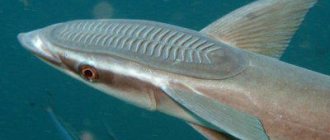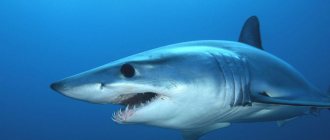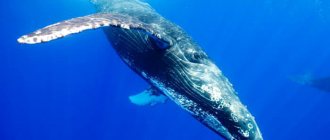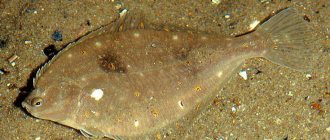Sharks are considered one of the most dangerous inhabitants of the seas and oceans - every year they commit hundreds of attacks on people, and in about ten cases they kill their victims. At the moment, scientists know more than 360 species of underwater predators, among which there are both small and defenseless and huge man-eating sharks. A large number of films have already been made about them, starting from the classic “Jaws” in 1975, and ending with the relatively recent “Meg: Monster of the Depth” in 2022. But are they as scary as they appear in the movies?
Nobody wants to meet a shark in the ocean.
Despite the great diversity, only 10 species of sharks are considered truly dangerous to people. Scientists recently discovered that they all descended from the same ancestor, who lived on Earth about 165 million years ago. The ancestor of modern killers was not as scary as one might initially assume - the length of the ancient shark Palaeocarcharias stromeri did not exceed one meter, and it fed exclusively on small fish. Her descendants are much scarier and more dangerous.
In 2022, Universal released the film "Toxic Shark" (Russian title: Poisonous Shark or Toxic Shark ). This is a science fiction film about a poisonous shark that uses toxic poison, destroying everything in its path.
Reef shark
This shark species primarily lives in the Indian and Pacific oceans. They prefer clear water and are often found near coral reefs and underwater cliffs. In addition to the fact that they can frighten with a chilling look, they are very large in size - the length of a reef shark reaches two meters.
Despite all this, they attack people extremely rarely - in 2011, there were only 11 known cases of reef shark attacks on people, and none of them were fatal. Sharks only show aggression if provoked, but in calm circumstances they easily swim up to divers and allow themselves to be hand-fed.
This shark doesn't look scary at all.
Diversity of aquatic predators
Among these predators, up to four hundred species are distinguished, and there are both small and very large sharks. Not all of them are dangerous to humans. Despite this diversity, there is no doubt which group of animals the shark belongs to.
The main thing that does not make it a mammal is that it does not feed its young with milk. Over many years of evolution, the inhabitants of the oceans have developed into dangerous and skilled predators with excellent hearing and sense of smell, which really helps these creatures smell blood at a great distance. However, sharks do not even have a hint of feeding with milk.
Therefore, the answer to the question of whether a shark is a fish or an animal is obvious - a fish. You can also highlight the following differences between marine mammals and fish:
- the cubs are born immediately independent, there is no need to take care of them or teach them how to hunt;
- sharks hardly sleep, they move non-stop;
- fish have a large set of sensory organs that help in obtaining food.
Another name for these creatures is selachia. All the myths, legends and speculations that surround them arose due to a lack of knowledge about them. However, during World War II, predators often attacked people participating in battles in the Pacific and Indian Oceans. There was a need to study them and find a way to protect against selachy.
Baby sharks are born immediately independent and do not need to be cared for
lemon shark
This species of shark typically lives in shallow bays - parts of the seas separated from open waters by rocks that protect them from wind and waves. The length of adult individuals is about 3 meters, and the weight reaches 180 kilograms. Typically, these sharks hunt only at night, and primarily feed on fish and shellfish.
Due to their large size, they are considered potentially life-threatening to humans. However, no fatal attacks have yet been recorded in history. There is a known case when a lemon shark attacked a diver with a GoPro camera - fortunately, the person was not injured, which cannot be said about the recording equipment.
Megalodon
0
See all photos in the gallery
Okay, this shark existed 2.6 million years ago - but we couldn’t help but include the largest representative of the species in our selection. Megalodon reached 30 meters in length: in this picture (scientists created it thanks to the remains found) the monster is hunting two whales at once. Several people could easily fit in the megalodon's jaws.
Blue shark
Blue sharks are considered the most common on Earth - you can meet them both in the open ocean and on the coasts of different countries. Their body length reaches four meters, and their weight is 400 kilograms. This type of shark has practically no enemies, with the exception of people who catch them both for entertainment and for cooking.
Of course, because of such hostility, people often become their victims. Thus, in 2011, 34 attacks by blue sharks were recorded, resulting in the death of 8 people. In 2022, there were even more victims - these predators ate more than 30 people off the coast of the Mediterranean Sea.
Blue shark himself.
Which vacation spots are more likely to be attacked by sharks?
The statistics of attacks changes from year to year - dangerous beaches, which previously frightened tourists with frequent shark attacks, become quiet, and safe ones suddenly turn into a real oasis for sharks.
This happened recently, when a number of coasts, after climate and other changes, became potentially dangerous in terms of possible collisions with sharks.
Egypt. Sharm El Sheikh
In 2010, the entire public was stunned by news from resort areas in Egypt, when 5 unprovoked shark attacks resulted in 1 death. The following season the attacks were repeated.
Tourists were horrified, although the appearance of sharks off the coast of the Red Sea in Egypt is quite natural; their range is quite wide.
Watch videos - Killer sharks at Egyptian resorts:
sand shark
This type of shark is also widespread and is found in almost all warm seas. They prefer to live close to the shore, and spend most of their time at the bottom, feeding on small fish, stingrays and other aquatic life. It is noteworthy that sand sharks are the only predators of their kind that can swallow air for easier swimming on the water surface.
Statistics say that from 1990 to 2011, sand sharks attacked people as many as 30 times - one person could not be saved and he died. Despite this, aquarium owners still consider sand sharks to be relatively safe creatures and place them inside huge aquariums, allowing visitors to swim next to them.
Differences between sharks and animals - breathing and blood flow
The main similarity between sharks and fish is respiration through gills. No mammal has gills as adults. Blood from the heart flows to the gills, where it is enriched with oxygen and distributed by the circulatory system throughout the body.
And here we come across the first difference. What does it consist of?
To move such a huge mass at such a high speed, a two-chambered heart is not enough. And muscles come to the aid of these predators. We encounter a similar system when getting acquainted with the venous circulation in humans, for example.
In our country, in order to return blood to the heart through the veins, which, unlike arteries, have less developed muscle fibers in the walls, contractions of skeletal muscles are necessary. We see the same thing with sharks.
Watch video - Shark circulatory system:
Here we discover another difference between marine predators and other fish. The large muscles of sharks are very densely intertwined with a network of blood vessels. These muscles, through their contractions, help blood return to the heart, since the pressure created by the heart alone is not enough.
During movement, the muscles of the locomotor system generate heat and transfer it to the vessels, making the blood of sharks warmer than their environment. The temperature difference can reach 10 degrees.
But this is not typical for all sharks, but only for the great white, blue shark, mako shark and some others. However, even these sharks are considered cold-blooded.
Watch video - Shark's Breath:
Sharks, again unlike other fish, do not have a swim bladder. Only sand sharks are the lucky owners of an air pocket that contains air. Due to the absence of a swim bladder, the process of descending to depth and rising to the surface is regulated by movement. A huge liver filled with fat gives sharks some buoyancy.
So movement is vital for a shark, and that is why it practically does not sleep. And if he decides to rest, then only in a place where there are strong currents that provide the gills, and accordingly the whole body, with a constant flow of oxygen.
Great hammerhead shark
These sharks, which live in warm and temperate waters, are truly huge - the body length of some individuals reaches six meters. As the name suggests, these predators have a very unusual head shape that looks like a hammer. Like the species described above, these underwater “hammers” mainly feed on fish, but there are cases where they even ate their relatives.
In 2011, biologists recorded 34 hammerhead shark attacks on humans, one of which was fatal. In fact, such a small number of deaths is very surprising - when attacking, they behave extremely sharply and aggressively, and with their strong teeth they can literally tear people apart.
This is also a shark!
Appearance and features
Photo: Giant shark in the ocean
Giant sharks have a rather specific appearance. The body is loose, the weight of the animal can reach four tons. The huge mouth and large gill slits stand out clearly against the background of the entire body. The cracks are constantly swelling. The body length is at least three meters. The body color is gray-brown and may include speckles. The shark has two fins on its back, one on its tail and two more on its belly.
Video: Giant shark
The fin located on the tail is asymmetrical. The upper part of the caudal fin is slightly larger than the lower part. The shark's eyes are round and smaller than those of most of its relatives. However, this does not affect visual acuity in any way. Giant fish have excellent vision. The length of the teeth does not exceed five to six millimeters. But this predator does not need large teeth. It feeds only on small organisms.
Interesting fact: The largest basking shark was a female. Its length was 9.8 meters. According to unconfirmed reports, there are individuals in the oceans whose length is as much as fifteen meters. And the maximum weight that has been officially registered is four tons. The length of the smallest shark caught was 1.7 meters.
Longtip shark
These predators live in all oceans, but choose places with the warmest water. As a rule, they feed on fish, but their method of eating aquatic inhabitants is very unusual - they open their mouths wide and quickly swim towards clusters of fish so that they themselves fly into their huge mouth.
Decades ago, longtip sharks were called dogs of the sea because they often chase passing ships. Legendary explorer Jacques-Yves Cousteau called them the most dangerous sharks in the world. The most famous attack by longtip sharks occurred during the Second World War - then the Nova Scotia with 1000 passengers sank off the coast of South Africa, and most of them were torn to pieces by this particular type of shark.
Longtip shark
Mysterious depths of the seas and oceans
The depths of the sea have always attracted and continue to attract people with their mystery. They have long been considered the mysterious and fabulous kingdom of Neptune and Leviathan. Stories about amazing, unseen animals sometimes frightened the most experienced sailors.
The world's oceans attract both extreme sports enthusiasts and scientists with their secrets and riddles. Only a fraction of the living organisms inhabiting vast layers of water are known today. Among the most famous are sharks (information about where sharks are found is later in the article). Only a few of the species pose a real danger to humans.
There are other deep-sea fish in the sea that have an unusual appearance and peculiar behavior. Nevertheless, they are all real inhabitants of the seas and oceans.
Mako shark
This species of shark, which lives in temperate and tropical seas, is terrifying not so much with its 4-meter body as with its agility. It is known that the speed of the mako shark reaches 74 kilometers per hour. At the same time, she can jump out of the water to a height of 6 meters - it’s scary to imagine how cruelly she can kill a person sitting calmly in a boat. There are as many as 20 such cases in history, but, fortunately, as a result, damage was caused only to swimming equipment.
As a rule, this type of shark hunts close to the shore, and sometimes eats fish caught in fishing nets. From 1980 to 2010, 42 attacks on humans were recorded, three of which were fatal. Usually the attack is made from the bottom up - the predator instantly bites off a piece of the victim's flesh. A person may well die from the injury he receives.
It looks creepy.
Origin of the species and description
Photo: Giant shark
Giant sharks belong to the species “Cetorhinus Maximus”, which can literally be translated as “The Greatest Sea Monster”. This is exactly how people describe this fish, amazed at its large size and terrifying appearance. The British call this shark "Basking", which means "Warmth-loving". The animal received this name for its habit of exposing its caudal and dorsal fins from the water. It is believed that this is how the shark basks in the sun.
Interesting fact: The giant shark has a very bad reputation. In the eyes of people, she is a ferocious predator, capable of swallowing a person whole.
There is some truth in this - the size of the animal really allows it to completely swallow the average person. However, people are not at all interested in basking sharks as food. They feed exclusively on plankton.
The basking shark is a large pelagic shark. It is part of the monotypic family. This is the only variety that belongs to the monotic genus of the same name - “Cetorhinus”. As noted above, this species occupies the second place of honor in terms of size of fish. This species is classified as a migratory species of animals. Basking sharks are found in all temperate waters, living both alone and in small schools.
Tiger shark
This type of shark is also extremely common, and you can meet it almost everywhere. The length of tiger sharks sometimes exceeds 5 meters, and they are practically omnivorous - in addition to the remains of fish, birds and turtles, inedible objects are sometimes found in their stomachs. They can eat all this thanks to their huge mouth with developed muscles.
There are many cases in history where human bodies were found inside tiger sharks. For example, in 1937, one of these predators attacked two boys and was subsequently killed and dissected - the children's bodies were found in his stomach. By 2011, scientists had recorded 169 tiger shark attacks on people, and 29 of them were fatal. On average, there are 3-4 attacks per year in Hawaii.
The famous tiger shark.
Reproduction - the difference between sharks and animals and fish
One of the main distinguishing features of sharks that sets them apart from fish is internal fertilization. This type of fertilization can only be found in guppies, swordtails, and a couple of other species of bony fish.
The back of the ventral fin is modified into two organs called pterygopodia. According to one of them, at the moment of fertilization, the sperm enters the female’s cloaca.
According to the type of reproduction, sharks are divided into viviparous, oviparous and ovoviviparous.
In oviparous sharks, during the process of formation, the egg passes through special glands, which supply it with a protein shell and a hard shell (often with special outgrowths). By the way, shark eggs have a large supply of nutrients necessary for the development of the embryo.
It doesn’t look much like animals, more like birds, doesn’t it?
Watch video - Shark Egg:
Birth of an angel shark:
There are, however, as we have already mentioned, sharks that are similar to animals in their type of reproduction. These are viviparous sharks. These sharks have an expanded section of the oviduct, a kind of “uterus” - a chamber in which fertilized eggs develop.
Moreover, the development of the embryo occurs first thanks to its own reserves of nutrients, and over time, contact occurs between the growing baby shark and the mother’s placenta, through which nutrients come directly from the mother’s body.
White shark
This species of shark is considered one of the most dangerous and tenacious, but at the same time is on the verge of complete extinction - at the moment, biologists know of the existence of only 3,500 individuals. They are found in open waters and coastal areas of almost all the oceans of the planet, and with a mass of more than 1900 kilograms they reach 6 meters in length.
In the classic horror film Jaws, this particular species of shark was depicted as a bloodthirsty man-eater. All this is not without reason, because from 1990 to 2011, biologists recorded about 139 cases of white shark attacks on humans, and 29 of them were fatal. With all this, most often people manage to escape after the first attack, but after severe bites they still risk becoming disabled.
White shark.
Bull shark or bull shark
flickr.com
The blunt-nosed shark, or gray bull shark, or bull shark (lat. Carcharhinus leucas) is a species of shark of the genus of gray sharks of the same family from the order Carcharhiniformes. This shark species is tolerant of a wide range of water salinities. The blunt-nosed shark lives at depths of up to 152 m and swims into fresh waters over long distances upstream in rivers.
They are large in size, with powerful jaws and an aggressive nature. In addition, the blunt-nosed shark is found in muddy water in shallow waters, in rivers. Because of this, it is one of the most dangerous shark species to humans. Until 2013, 67 unprovoked non-lethal attacks and 26 fatalities were recorded.
Habitat
They are distributed from Massachusetts to southern Brazil, from Morocco to Angola, near South Africa, Kenya, India, Vietnam and Australia. In the Pacific Ocean, blunt-nosed sharks live from Baja California to Ecuador.
There are entire populations of these sharks in rivers - more than 500 individuals live in the Brisbane River (Australia).
They penetrate the Ganges, Brahmaputra, Zambezi and many other rivers in Asia, Africa, America and Australia. Sharks have been seen in the Amazon, Mississippi, Lake Michigan and Lake Nicaragua.











